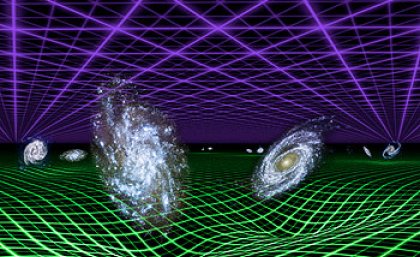
An Australian-based astronomy team, co-led by Professor Michael Drinkwater from the School of Mathematics and Physics (SMP) at The University of Queensland (UQ), has shown that the mysterious ‘dark energy’ is indeed real and not a mistake in Einstein’s theory of gravity.
Using the Anglo-Australian Telescope, 26 astronomers (from 14 different institutions) contributed to the ‘WiggleZ Dark Energy Survey’, which mapped the distribution of galaxies over an unprecedented volume of the Universe.
Because light takes so long to reach Earth, it was the equivalent of looking seven billion years back in time – more than half way back to the Big Bang.
“This is the first individual galaxy survey to span such a long stretch of cosmic time,” said Professor Drinkwater said.
It was only possible thanks to new Australian technology.”
The survey, which covered more than 200,000 galaxies, took four years to complete and aimed to measure the properties of ‘dark energy’ - a concept first cast by Einstein in his Theory of General Relativity.
The scientist adapted his original equations to include the idea and later ruefully admitted that it was "his greatest blunder".
Dark energy is the name astronomers gave in the late 1990s to an unknown cause of the Universe’s accelerating expansion.
This mysterious energy, that defies gravity, makes up about 72 percent of the Universe, with the remaining 24 percent constituting dark matter, and 4 percent making up the planets, stars and galaxies that we normally hear about.
“The discovery of acceleration was an enormous shock, because it went against everything we thought we knew about gravity,” co-researcher Dr Tamara Davis from the University of Queensland said.
“The problem was, that supernova data couldn’t tell us whether dark energy was genuinely there, or whether Einstein’s theory of gravity itself was failing."
WiggleZ used two other kinds of observations to provide an independent check on the supernova results.
One measured the pattern of how galaxies are distributed in space and the other measured how quickly clusters of galaxies formed over time.
“WiggleZ says dark energy is real. Einstein remains untoppled,” said Dr Chris Blake, of Swinburne University, lead author of the recent findings, which will be published in two papers in the Monthly Notices of the Royal Astronomical Society.
According to Professor Warrick Couch, Director of the Centre for Astrophysics and Supercomputing, confirming the existence of the anti-gravity agent is a significant step forward in understanding the Universe.
“Although the exact physics required to explain dark energy still remains a mystery, knowing that dark energy exists has advanced astronomers’ understanding of the origin, evolution and fate of the Universe,” he said.
The WiggleZ observations were possible due to a powerful spectrograph located at the Anglo-Australian Telescope.
The spectrograph was able to image 392 galaxies an hour, despite the galaxies being located halfway to the edge of the observable Universe.
“WiggleZ has been a success because we have an instrument attached to the telescope, a spectrograph, that is one of the best in the world for large galaxy surveys of this kind,” said Professor Matthew Colless, director of the Australian Astronomical Observatory.
The Wigglez survey involved 18 Australian astronomers, including 10 from Swinburne University of Technology.
It was led by Dr Chris Blake, Professor Warrick Couch and Professor Karl Glazebrook from Swinburne and Professor Michael Drinkwater from the University of Queensland.
The team members who spearheaded the cosmological analysis presented in these papers were Dr Chris Blake and Dr Greg Poole from Swinburne University of Technology and Dr Tamara Davis and Dr David Parkinson from The University of Queensland.
Media Contacts: Professor Michael Drinkwater (0432 887 642, m.drinkwater@ uq.edu.au) or Dr Tamara Davis (0432 526 989, tamarad@ physics.uq.edu.au); SMP Communications Office: Aarti Kapoor (07 3346 9935, a.kapoor@uq.edu.au)
High resolution files are online at: http://www.physics.uq.edu.au/people/mjd/darkenergy/
IMAGE 1 -- Dark Energy and Gravity: Yin and Yang of Universe
Image credit: NASA/JPL-Caltech
LONG CAPTION
Astronomers think that the expansion of the universe is regulated by both
the force of gravity, which acts to slow it down, and a mysterious dark
energy, which pushes matter and space apart. In fact, dark energy is
thought to be pushing the cosmos apart at faster and faster speeds,
causing our universe's expansion to accelerate.
In this artist's conception, dark energy is represented by the purple grid
above, and gravity by the green grid below. Gravity emanates from all
matter in the universe, but its effects are localized and drop off quickly
over large distances.
New results from NASA's Galaxy Evolution Explorer and the Anglo-Australian
Telescope atop Siding Spring Mountain in Australia confirm that dark
energy is a smooth, uniform force that now dominates over the effects of
gravity. The observations follow from careful measurements of the
separations between pairs of galaxies (examples of such pairs are
illustrated here). The results are one of the best confirmations of the
nature of dark energy to date.
SHORT CAPTION
New results from NASA's Galaxy Evolution Explorer and the Anglo-Australian
Telescope atop Siding Spring Mountain in Australia confirm that dark
energy (represented by purple grid) is a smooth, uniform force that now
dominates over the effects of gravity (green grid). The observations
follow from careful measurements of the separations between pairs of
galaxies (examples of such pairs are illustrated here).
IMAGE 2 -- How to Measure the Universe
Image credit: NASA/JPL-Caltech
LONG CAPTION
This diagram illustrates two ways to measure how fast the universe is
expanding. In the past, distant supernovae, or exploded stars, have
been used as "standard candles" to measure distances in the universe,
and to determine that its expansion is actually speeding up. The
supernovae glow with the same instrinsic brightness, so by measuring
how bright they appear on the sky, astronomers can tell how far away
they are. This is similar to a standard candle appearing fainter at
greater distances (left-hand illustration).
In a new survey from NASA's Galaxy Evolution Explorer and the
Anglo-Australian Telescope atop Siding Spring Mountain in Australia
the distances to galaxies were measured using a "standard ruler"
(right-hand illustration). This method is based on the preference for
pairs of galaxies to be separated by a distance of 490 million
light-years today. The separation appears to get smaller as the
galaxies move farther away, just like a ruler of fixed length
(right-hand illustration).
SHORT CAPTION
This diagram illustrates two ways to measure how fast the universe is
expanding -- the "standard candle" method, which involves exploded stars
in galaxies, and the "standard ruler" method, which involves pairs of
galaxies.
.jpg)











